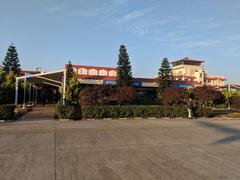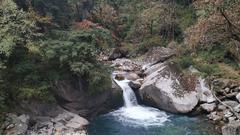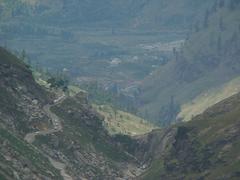Khirganga National Park Visiting Hours, Tickets, and Travel Guide – Himachal Pradesh Historical Sites
Date: 15/06/2025
Introduction
Khirganga National Park, nestled in the enchanting Parvati Valley of Himachal Pradesh, is a sanctuary where Himalayan natural grandeur meets profound cultural and spiritual heritage. Established in 2010 and covering approximately 710 square kilometers in the Kullu district, the park is a haven for unique ecosystems, rare wildlife, and indigenous communities like the Gaddi and Kinnauri tribes. Revered for its mythological significance—especially its famed hot springs believed to be created by Lord Shiva—Khirganga is both an ecological and spiritual destination (TourMitra; Greenverz).
This comprehensive guide provides detailed information on Khirganga National Park’s visiting hours, ticketing, accessibility, travel tips, and conservation initiatives. It also highlights the park’s historical, cultural, and ecological significance, along with nearby attractions and practical advice for an enriching Himalayan journey.
Table of Contents
- Historical Evolution and Cultural Significance
- Geography, Climate, and Ecology
- Flora and Fauna
- Spiritual and Community Life
- Conservation and Responsible Tourism
- Visitor Information
- Nearby Attractions
- Safety and Travel Tips
- Frequently Asked Questions (FAQ)
- Conclusion
- Sources
Historical Evolution and Cultural Significance
Khirganga National Park is one of the youngest protected areas in Himachal Pradesh. Its establishment in 2010 was a response to increased ecological awareness and the region’s growing popularity among trekkers and spiritual seekers. The area has long been home to indigenous Gaddi and Kinnauri communities, whose sustainable agricultural and pastoral practices have shaped the landscape (TourMitra; Wondering Destination).
Deeply woven into Hindu mythology, Khirganga is believed to be the site where Lord Shiva meditated for thousands of years. The mineral-rich hot springs are not only a natural marvel but also a spiritual attraction, drawing pilgrims seeking purification and healing.
Traditional festivals, music, dance, and handicrafts enrich the park’s cultural fabric. Community involvement in conservation and tourism has fostered a model of sustainable development that balances preservation with livelihood (Greenverz).
Geography, Climate, and Ecology
Geographic Setting
Khirganga National Park is situated within the Parvati Valley, ranging in altitude from roughly 2,000 meters to over 5,500 meters at its highest peaks (PeakVisor). It features dramatic elevation gradients, lush valleys, alpine meadows, dense coniferous forests, and snow-capped mountains. The Parvati River runs through the park, providing vital water resources for the region.
Climate and Weather Patterns
- Temperature: Ranges from 30°C in the lower valleys in summer to below freezing at higher elevations during winter.
- Precipitation: Heavy monsoon rains from June to September can render trails slippery and increase landslide risk. Winters (December–February) bring significant snowfall.
- Best Visiting Seasons: April–June and September–November, when the weather is pleasant and trails are accessible (Unacademy).
Flora and Fauna
Vegetation Zones
Khirganga’s diverse altitudinal range supports a mosaic of habitats:
- Subtropical and Temperate Broadleaf Forests: Oak, maple, chestnut, rhododendron.
- Coniferous Forests: Blue pine, deodar, spruce, fir.
- Alpine Meadows and Shrublands: Colorful wildflowers, shrub species, and high-altitude pastures (Greenverz).
Key Wildlife
- Mammals: Snow leopard, Himalayan brown and black bears, Himalayan tahr, bharal (blue sheep), musk deer, goral.
- Birds: Over 200 species, including the western horned tragopan, Himalayan monal, koklass pheasant, and Himalayan griffon.
- Other Fauna: Rare reptiles, butterflies, and amphibians thrive in the varied habitats.
The park serves as a crucial corridor for wildlife movement between the Great Himalayan National Park and surrounding protected areas.
Spiritual and Community Life
The hot springs at Khirganga village are central to the park’s spiritual appeal, hosting religious rituals and festivals (TourMitra). Ancient temples and shrines dot the region, maintained by local priests.
The Gaddi and Kinnauri communities practice sustainable grazing, herbal medicine collection, and handicraft production. Festivals such as Phagli and Fagli celebrate agricultural cycles, honor local deities, and foster community bonds. Community-based ecotourism initiatives provide alternative livelihoods and promote conservation (Wondering Destination).
Conservation and Responsible Tourism
Management is overseen by the Himachal Pradesh Forest Department, with active involvement from NGOs and local communities. Conservation strategies include anti-poaching patrols, habitat restoration, and educational outreach to document and preserve indigenous knowledge (TourMitra). Sustainable tourism is encouraged through regulations on group sizes, eco-friendly accommodations, and visitor education.
Visitor Information
Visiting Hours
- Open: Daily from 7:00 AM to 6:00 PM (times may vary seasonally).
- Overnight Stays: Permitted only at designated campsites and guesthouses with prior approval.
Ticket Information
- Entry Permits: Required for all visitors; available at park entrances or online via the Himachal Pradesh Forest Department.
- Fees: Approx. ₹100–₹250 for Indian citizens, ₹400–₹600 for foreign nationals (subject to change). Separate fees for cameras and trekking permits may apply (nationalparktravel.in).
How to Reach
- By Air: Bhuntar (Kullu–Manali) Airport, ~30–50 km from the park.
- By Rail: Joginder Nagar, ~125 km away.
- By Road: Accessible by road to Kullu, Manikaran, and Barshaini (common trek starting point).
- Trekking: Popular 12 km trek from Barshaini to Khirganga village (learnupsc.com).
Best Time to Visit
- April–June, September–November: Pleasant weather, accessible trails, and vibrant flora.
- December–March: Snowfall limits access; suitable only for experienced trekkers (easeindiatrip.com).
Accessibility and Facilities
- Terrain: Rugged, with moderate to challenging treks; not suitable for those with mobility issues.
- Accommodation: Homestays, guesthouses, basic campsites, and forest rest houses (book in advance).
- Food: Small eateries and tea stalls near villages and along trekking routes.
Guided Tours and Special Events
- Guided Treks: Local operators offer trekking, birdwatching, and cultural tours.
- Special Events: Cultural festivals and spiritual gatherings at hot springs and temples.
Photographic Spots
- Hot Springs: Khirganga village.
- Alpine Meadows: During spring and summer blooms.
- Panoramic Views: Sunrise and sunset from elevated trails.
- Wildlife: Observation points along forest and meadow trails.
Nearby Attractions
- Parvati Valley: Trekking routes and scenic beauty.
- Kasol: Popular with travelers for its cafes and cultural blend.
- Manikaran Sahib: Hot springs and religious sites.
- Great Himalayan National Park: Extended wildlife and trekking experiences.
- Kullu Town: Temples, bazaars, and historical sites.
Safety and Travel Tips
- Acclimatize: Altitude sickness is a risk; ascend gradually.
- Weather Preparedness: Carry layered clothing, rain gear, and sunblock.
- Trekking: Use sturdy boots and trekking poles; avoid monsoon and deep winter treks unless experienced.
- Health: Carry a personal medical kit; nearest hospitals are in Kullu and Manikaran.
- Wildlife Safety: Do not approach or feed animals; follow guide instructions.
- Environmental Respect: Practice Leave No Trace, avoid plastics, and respect local customs.
Frequently Asked Questions (FAQ)
Q: What are the park’s visiting hours?
A: 7:00 AM to 6:00 PM daily; overnight stays require prior permission.
Q: How do I buy entry tickets?
A: At park entrances or online at the Himachal Pradesh Forest Department.
Q: Are guided tours available?
A: Yes, local operators offer guided treks and wildlife tours.
Q: Is the park accessible for differently-abled visitors?
A: Rugged terrain limits accessibility; nearby villages offer some facilities.
Q: What should I pack?
A: Warm clothing, rain gear, sturdy shoes, insect repellent, water, and a first-aid kit.
Conclusion
Khirganga National Park stands as a Himalayan treasure, blending spectacular natural beauty, rare wildlife, vibrant culture, and deep spirituality. Plan your visit between April and November for the best conditions, and purchase tickets online or onsite. Support local communities, practice responsible tourism, and immerse yourself in the park’s unique offerings—from hot springs and alpine meadows to festivals and wildlife.
For real-time updates, trekking routes, and personalized itineraries, download the Audiala mobile app. Stay connected through official tourism channels, and explore related guides on Himachal Pradesh historical sites and Himalayan travel.
Embark on your Khirganga adventure and experience the harmony of nature, culture, and spirituality in the heart of the Himalayas.
Sources
- Khirganga National Park: Visiting Hours, Tickets, and Cultural Heritage in Himachal Pradesh, 2023, TourMitra (TourMitra)
- Khirganga National Park: Visiting Hours, Tickets, and Exploring Kullu’s Natural Wonder, 2023, Greenverz (Greenverz)
- Khirganga National Park: A Visitor’s Guide to Biodiversity, Attractions, and Travel Tips, 2023, PeakVisor & Unacademy (Unacademy)
- Khirganga National Park Visiting Hours, Tickets, and Travel Guide to Himachal Pradesh’s Himalayan Gem, 2023, LearnUPSC & NationalParkTravel (learnupsc.com), (nationalparktravel.in)
- PeakVisor - Khirganga National Park
- Incredible India - Khirganga National Park
- TripXL Blog on Khirganga National Park
- Rishikesh Day Tour - Wildlife Viewing Tips
- Wikipedia - Khirganga National Park



